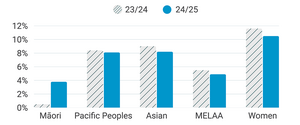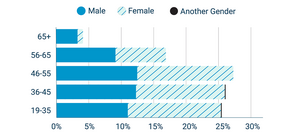Manaaki Tangata: Diversity, equity and inclusion information for 2024/25
Manaaki Tangata (Diversity and Inclusion Policy) is our guiding framework. It sets out our commitment to fostering and promoting diversity and inclusion across our organisation. This framework ensures these principles are embedded in all our people and culture initiatives and helps our people understand what they can expect from Toitū Te Whenua.
As part of our commitment to Manaaki Tangata, we regularly review the makeup of our workforce to understand pay gaps and the diversity of age, gender, and ethnicity across the organisation, including leadership roles. The data below shows our current workforce composition as at 30 June 2025.
Pay gap

Tabular data - Pay gap
| 23/24 | 24/25 | |
|---|---|---|
| Māori | 0.5% | 3.8% |
| Pacific Peoples | 8.4% | 8.1% |
| Asian | 9.0% | 8.2% |
| MELAA | 5.5% | 4.9% |
| Women | 11.6% | 10.5% |
Age and gender

Tabular data - Age and gender
| Age | Male | Female | Another gender |
|---|---|---|---|
| 65+ | 3.2% | 0.8% | 0.0 |
| 56-65 | 9.1% | 7.8% | 0.0 |
| 46-55 | 12.5% | 14.9% | 0.0 |
| 36-45 | 12.4% | 13.7% | 0.1 |
| 19-36 | 11.0% | 14.4% | 0.1 |
Ethnic Diversity

Tabular data - Ethnic diversity
| European | 65.0% |
|---|---|
| Māori | 9.6% |
| Pacific Peoples | 4.3% |
| Asian | 12.3% |
| MELAA | 1.3% |
Leadership
Women and leadership
| Level of leadership | Percentage |
|---|---|
| Leadership | 45.8% |
| Senior leadership (tier 1-3) | 59.4% |
Ethnicity and leadership
| Ethnicity | Percentage |
|---|---|
| NZ Māori | 5.9% |
| Pacific Peoples | 3.8% |
| Asian | 3.8% |
| MELAA | 0.5% |
| Non-European | 11.8% |
Overall employee numbers and reporting
819.5 full time employed (FTE)
| Reporting | Percentage |
|---|---|
| Employees who self-report on gender | 100% |
| Employees who self-report on ethnicity | 95% |
| Employees who reported having a disability | 5.8% |